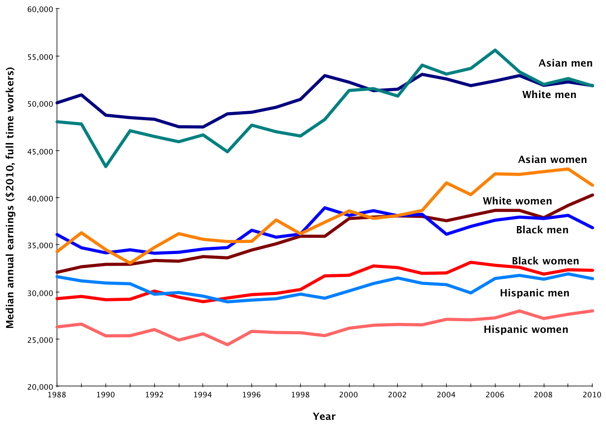Minorities have historically had to climb up the wage ladder in U.S. history. At the top of that ladder has traditionally been white men, until recently Asian males usurped that glory, graphed out below. However, overall white males still earn more than any other demographic in this country because of a variety of cultural and societal factors that go far above and beyond their sheer numbers in the workforce. I'm not blogging about this to place gender 'blame' - we're all adults here and we have things to work out. I understand there is denial on the part of some individuals to accept that pay inequality is real - yes, even when you compare apples and apples, not just averages.
Put your hackles down doubters and chill with me as we explore this controversial topic.
Though it is beginning to erode among young women, those factors are well documented here and here, for example. I don't have all day to write this post to address every issue of disparity - it's a blog post not The Iliad and The Odyssey. And, I haven't conducted any original research so I'm linking resources you can read yourself along the way if you want to really dig deeply into citizens ofcomparableeducation and experience earning (or not) comparablewages.
Here's what NYTimes.com had to say about apples and apples in the over $100k C-level employee in 2009 based on PayScale data analysis.
After controlling for outside factors, some of the biggest gender pay gaps are in jobs like chief executive (in which, after PayScale adjusted the data, women earn 71 percent of what men earn), hospital administrator (women earn 77 percent of what equally qualified men earn) and chief operating officer (women earn 80 percent of what equally qualified men earn).
While that sucks, what I want to focus on for this post is that for many industries there is evidence that just one year out of school the gender wage gap is operational - yes readers, even for grads who had the same major. Shocking? It should be (and shouldn't be, given our national history of minority groups having to fight for and crawl out of inequality of just about everything at one time or another).

The above chart comes from The American Association of University Women (AAUW) which has conducted comprehensive research into the gender pay gap. Founded in 1881, their mission is toadvance equity for women and girls through advocacy, education, philanthropy, and research.
You might expect the pay gap between men andwomen in this group of workers of similar age,education, and family responsibilities to be smallor nonexistent. But in 2009the most recentyear for which data are availablewomen oneyear out of college who were working full timeearned, on average, just 82 percent of what theirmale peers earned. After we control for hours,occupation, college major, employment sector,and other factors associated with pay, the paygap shrinks but does not disappear. About one third of the gap cannot be explained by any ofthe factors commonly understood to affect earnings, indicating that other factors that are moredifcult to identifyand likely more difcult tomeasurecontribute to the pay gap.
The AAUW report Graduating to a Pay Gaphas the rest of the goods.
Look, the gap is taking too long to close. It's like an ulcerated lesion on the buttocks of this country. It's high time to:
- Pass the Equal Rights Amendment (sign the whitehouse.gov petition).
- Teach women more positive, assertive negotiation skills.
- Motivate employers to implementaudits to monitor and address gender pay differences andeliminate pay disparities betweenfemale-dominated and male-dominated jobs that require comparable levels
- Encourage female children to consider STEM careers.
- Be in favor of pay equality FOR ALL. For example, as noted in the graph above, pay discrimination also impacts men of color. Men of color also experience wagediscrimination. African American men earn 76 cents and Latinos earn only 66 cents forevery dollar paid to their white male counterparts.
- Check out this AAUW Pay Equity Resource Kit and get even educated on the facts - then educate others, organize a talk, blog about it and contact your legislators to tell them you oppose pay inequality.
- Provide men with the same parental leave time as women so that men and women can have more similarities in employment, family responsibility and work life balance.
Maybe the gender pay gap will never go completely away. After all, it's 15% even in Utopian Sweden. That doesn't mean we can't do everything possible to narrow it as much as possible.
What's your idea to narrow the gap?

Leave a Reply